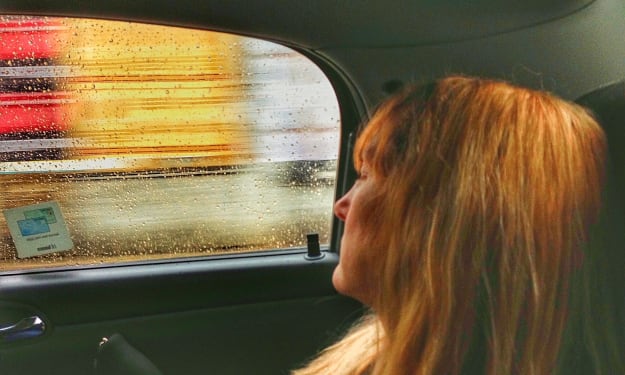'LDR:' Brave, Bold and Not Afraid of Technology
'Love, Death and Robots' is many things, but it is not a technophobe.

Love, Death and Robots (LDR) is now streaming on Netflix. LDR is a series of 18 episodes of short animations.
Each episode is different in the graphics and animation style. Some episodes are using classic animation style, and some of them are advanced CGI with the ultra-realistic atmosphere. Even in one event, Ice Age, there is a combination of animation and real actors.
Each episode of LDR has an independent storyline and happens in different time, space or reality.
LDR is a show off for the power of the pure imagination. The storytellers didn’t limit themselves. Not in style, not in the subject nor in the representation. If they thought they needed to show the violence, they didn’t back off. If they felt that they needed to show nudity, they went for it unapologetically. If they couldn’t tell their story on Earth, they changed the space, and if the timeline was not right for them, they tried to go to an alternative time. Even if it was necessary, they gave the control of our society to The Yogurt, (When The Yogurt Took Over).
This show which is produced by a few big names in the industry including David Fincher, Joshua Donen, David Fincher, Jennifer Miller, and Tim Miller (director of Deadpool), is generating lots of debate online. People are debating about different aspects of this animation series from the style of each episode to the choices of directors in respect of showing violence, nudity or the role of the women in the stories.
It is not surprising in such diverse and different basket of stories you will find many different things to talk about. But interestingly enough, there is one thing that is missing—or at least it is not at the center of the stories—and, lack of this issue is good.
When I started to watch the LDR, I was sure that I will witness the technophobic view in the stories.
Technophobia has a long history. The idea that advancement in the technology will eventually make us more vulnerable and at the end, these technologies—directly or indirectly—will fail us.
You can even follow these ideas in ancient myths.
In Greece mythology, during the escape from Crete, Icarus and his father were using the feather wings that were attached together by wax to fly from the prison. Icarus wanted to get closer to the Sun and ignored the advice of his father. As a result, waxes of the wing melted, and he fell to his death. Some can argue the lesson here is that even if you need to use the technology to gain an ability which is not natural for you, you should use it with limitation and not give in to the seduction of reaching places that you aren't supposed to be.
The same theme reappears in different myths over and over again.
In Persian mythology, there is a story of an ancient king of Persia (Iran) who is known as Kay Kāvus. According to the Ferdowsi’s Shahnameh (The Book of the Kings), he invented a flying throne. He attached four sides of his throne to the legs of four giant eagles and then put a portion of food on the sticks over the heads of the eagles. For reaching the food, eagles took off the Earth and carried the throne with themselves. Of course, the navigation system of this throne couldn’t be worst. But according to the legend, he actually flew on this flying throne from Iran to China, and it was there that things went south, eagles got tired, and landed in a land that they should not have. The King got imprisoned till the famous Persian hero, Rostam freed him. The reason for Kay Kāvus failure was his temptation to go beyond and push technology to its limit.
In the modern age, the theme of technophobia is dominating narrative in the science fiction and also perspective of the future.
Frankenstein; or, The Modern Prometheus, written by Mary Shelley, is considered as one of the first science fiction stories of the modern times and at the core, there is fear of futuristic and unhinge technology. You can follow this trend to this day. Dark Mirrors TV series is one of the most famous examples of the new representation of the devastating future created by technologies. The unleashed technologies which bring us to the brink of distinctions or blind us toward the reality are at the core of a few subgenres of science fictions and post-apocalypse stories.
Technophobia is not just a theme in the literature. This idea is playing a significant role in the social and political landscape too. From the Luddites movement in the 19th century to anti-automation activists, there are many examples of social movements that put the technophobia at their hearts.
We have a school of thought which is called Technology Determinism and it believes, as Raymond Williams puts it: “Technology determines History.” And this determination—at least in one of the interpretations of this idea—is inevitable and out of the our control. Some ideas which have root in this ideology created a lot of buzz in recent years. Among those, is the idea of “technological singularity.”
This idea also has been used by the totalitarian regimes as an excuse for censorship. After the Islamic revolution in Iran in 1978, it was a long campaign against communication and entertainment technologies. There was a long period that the video player became illegal in Iran, and the argument behind that was, no matter how you use video player, at the end it will destroy families and traditions and your life. For a long time if you wanted to use the fax machine you had to get a special permit from the authorities and even right now, the use of the satellite receiver dishes and using many of social media is officially illegal in Iran. The argument is the same. It will destroy you and your country.
Of course, Iran is not the only place that these ideas became the governing state of mind.
Right now, in the US, the president publicly shows his disagreement with the advancement of technology. Not only he is citing the advantage of the wall over new surveillance and security-related technology for controlling the borders, he argues that advanced technology and its complexity is something we have to worry about. On March 12, and in response to news that a Boeing 737 Max 8 jet crashed in Ethiopia, President Trump tweeted:
“Airplanes are becoming far too complex to fly. Pilots are no longer needed, but rather computer scientists from MIT. I see it all the time in many products. Always seeking to go one unnecessary step further, when often old and simpler is far better.”
There are many concerns about the new technologies and their advancement, and there are legitimate and rational fears about them, but the technophobia, in general, does not focus on these rational fears and even suppresses them. Technophobia is playing with the sentiment instead of the facts and rationality, and maybe this is the reason why we have to be concerned about the trend of technophobia in our society and its effects on people’s lives and our future.
In this atmosphere, watching Love, Death and Robots is kind of fresh air.
This TV show has all the possible opportunity to tap the idea of technophobia. Many episodes of this show deal with advanced technological and at the same time post-apocalyptical societies. The space-time of stories, the medium and the potential audiences are all there for creating a “technophobia” centric show, and somehow, they figure out a way to don’t do that.
[Spoiler Alert]
Among 18 episodes of the LDR, at least eight of them are dealing with the advanced technological stories. ("Sonnie's Edge," "Three Robots," "Suits, When The Yogurt Took Over," "Beyond the Aquila Rift," "Good Hunting," "Zima Blue," and "Blindspot")
In episode one, "Sonnie's Edge," Sonnie is a woman who remotely controls a genetically-engineered monster in underground gladiator battles. But the devil here is not the technology or losing control of it. It is human nature. The greed and the power play.
Episode two or "Three Robots," is one of the great examples. This story happens in the post-apocalypse event. People have been vanished from the Earth, and their robots inherited it (also genetically engineered cats.) The story is about three tourist robots who are visiting the remains of a ruined city. This was a perfect setup to show us how the advancement of robotic technology led to the rise of machines and their uprising against the human. But the creators took another road. In this story, we have been destroyed by ignorance and lack of action against the real danger that threatened us: environmental challenges.
In the episode “Suits,” it turns out that the technology is actually protecting the characters against monsters. And you can find this different approach to the future of the technology in other episodes too.
One of the episodes that stands out is “Aquila Rift.” Not only the creators of this story show how the advanced VR technology could help to reduce the pain of lost travellers, but they go one step forward and show that how the alien monster that we are afraid of, could be a caring creature.
In this day and age that we are living in the post-fact era, where we can be easily distracted from the main challenges ahead of us, and we quickly get afraid, it is refreshing and hopeful to see such a new perspective emerge. Focusing on rational fears and worries instead of loud and distracting noises of technophobia.
About the Creator
Pouria Nazemi
Freelance science journalist based in Montreal, Canada







Comments
There are no comments for this story
Be the first to respond and start the conversation.